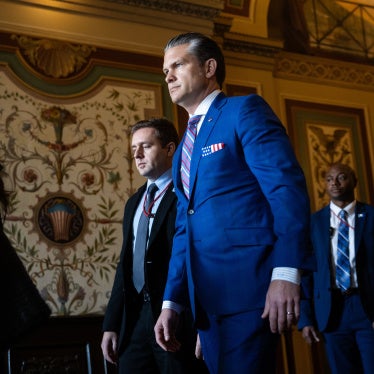Speaker Kevin McCarthy
2468 Rayburn H.O.B.
Washington, DC 20515
House Majority Leader Steve Scalise
2049 Rayburn H.O.B.
Washington, DC 20515
House Minority Leader Hakeem Jeffries
2433 Rayburn H.O.B.
Washington, DC 20515
Chair Cathy McMorris Rodgers
House Energy & Commerce Committee
2188 Rayburn H.O.B.
Washington, D.C. 20515
Ranking Member Frank Pallone
House Energy & Commerce Committee
2107 Rayburn H.O.B.
Washington, DC 20515
CC: Chairman Jim Jordan, House Judiciary Committee and Ranking Member Jerrold Nadler, House Judiciary Committee
RE: Vote NO on the HALT Fentanyl Act (H.R. 467)
Dear Speaker McCarthy, Majority Leader Scalise, Minority Leader Jeffries, Chair Cathy McMorris Rodgers, Ranking Member Frank Pallone, and Honorable Members of the U.S. House of Representatives:
The undersigned national, state, and local public health and criminal justice reform organizations write today to urge you to reject and vote NO on the Halt All Lethal Trafficking of Fentanyl (HALT) Act (H.R. 467). This bill permanently schedules fentanyl-related substances (FRS) on schedule I of the Controlled Substances Act (CSA) based on a flawed class definition, imposes mandatory minimums, and fails to provide an offramp for removing inert or harmless substances from the drug schedule.
The classwide scheduling approach endorsed in the HALT Fentanyl Act classifies all FRS as schedule I drugs, reserved for substances with no currently accepted medical use and a high potential for abuse.[1] This class definition, however, is a radical departure from drug scheduling practices as it relies exclusively on chemical structure without accounting for pharmacological effect based on the unproven hypothesis of chemical structure-function relationships.[2] Contrary to this hypothesis, structurally related substances can often have complementary therapeutic values. In fact, the National Institute on Drug Abuse (NIDA) has already acknowledged that some FRS are inert and that at least one may be an opioid antagonist that behaves like naloxone, which is itself an opium derivative that counteracts the effects of opioid drugs.[3] Classifying all FRS in schedule I places undue restrictions on research for therapeutic potential of FRS. This means that researchers and scientists are not able to study these substances at a time when the U.S. is experiencing record number overdose deaths.
The HALT Fentanyl Act also enshrines mandatory minimums for distribution of FRS under the Controlled Substances Act, an inappropriate mandate that criminalizes possibly inert or harmless substances. While some proponents of the HALT Fentanyl Act claim that the bill is not intended to interact with the criminal justice system and that mandatory minimums are primarily a deterrent against foreign import of FRS, this is simply inaccurate. The HALT Fentanyl Act expands mandatory minimums for both foreign importation crimes and domestic drug distribution offenses, including nonviolent drug distribution involving small quantities of drugs. What’s more, by automatically scheduling a huge swathe of substances in one fell swoop, the HALT Fentanyl Act would lead to very real criminal justice consequences, posing an unacceptable risk of unnecessary incarceration for substances that carry no potential for abuse. Such miscarriages of justice have already occurred. For instance, Todd Coleman was sentenced to a mandatory minimum of 10 years for sale of cocaine that a crime laboratory said was laced with three fentanyl analogues, only to discover, years later, that the detected adulterants were not illegal fentanyl analogues and most were not even controlled substances.[4]
Our country is repeating past missteps when it comes to policy responses to fentanyl and its analogues. In the 1980s, policymakers enacted severe mandatory minimums for small amounts of crack cocaine in response to media headlines and law enforcement warnings that perpetuated mythology and fear. These laws imposed harsher penalties for crack—a substance associated with Black people—than for cocaine—a substance associated with White people—even though the two substances are chemically similar. In the ensuing decades, people of color have been disproportionately incarcerated and sentenced to mandatory minimum sentences for small amounts of crack. The emergence of fentanyl-related substances in recent years has fueled similar waves of alarmist media and law enforcement headlines that are informed by mythology rather than science. Any further extension of the classwide scheduling policy threatens to repeat past missteps with crack cocaine that policymakers are still working to rectify.
The classwide scheduling policy expands the application of existing severe mandatory minimum sentencing laws enacted by Congress in the 1980s to a newly scheduled class of fentanyl-related compounds. For example, just a trace amount of a fentanyl analogue in a mixture with a combined weight of 10 grams—10 paper clips—can translate into a five-year mandatory minimum with no evidence needed that the seller even knew it contained fentanyl. In addition, current laws impose a statutory maximum sentence of 20 years for just a trace amount of a fentanyl analogue in a mixture with a combined weight of less than 10 grams.[5] The truth of the matter is that lawmakers do not need to impose new mandatory minimums in order to prosecute fentanyl analogue cases because law enforcement officials already have the ability to prosecute these cases pursuant to the Controlled Substance Analogue Enforcement Act of 1986, which requires that prosecutors show the substances in question are harmful.[6]
Despite the threat of grave injustices in the criminal legal system, the current lack of research on FRS, and indications that some FRS are harmless or hold therapeutic potential, the HALT Fentanyl Act does not include an offramp to reschedule or remove FRS that research has proven to be pharmacologically inactive or do not meet schedule I criteria. Though it includes research reforms for schedule I substances, the bill excludes the possibility of such research impacting the criminalization of FRS. Other proposed FRS legislation, including the Biden proposal for FRS, the Save Americans from the Fentanyl Emergency (SAFE) Act (H.R. 6946) introduced by Rep. Chris Pappas (D-NH), and the Temporary Emergency Scheduling and Testing of Fentanyl Analogues Act (TEST) Act of 2022 (S. 5167) introduced by Sen. Cory Booker (D-NJ), provide this offramp, ensuring that substances can be removed from schedule I to prevent miscarriages of justice. Without a rescheduling process, the HALT Fentanyl Act may unjustly promote criminalization of harmless or inert substances.
The HALT Fentanyl Act and other bills proposing the permanent classwide scheduling of FRS are yet another iteration of the drug war’s ineffective and punitive strategies. To prevent overdose, Congress must invest in a public health solutions to mitigate the harms of illicit fentanyl. We urge Congress to support bills like the Support, Treatment, and Overdose Prevention of Fentanyl (STOP Fentanyl) Act of 2021 (H.R. 2366) introduced by Rep. Ann Kuster (D-NH) and Rep. Lisa Blunt Rochester (D-DE), which proposes increased access to harm reduction services and substance use disorder treatment, improved data collection, and other evidence-based methods to reduce overdose, and the TEST Act, which provides funding for FRS research and offers alternative strategies to simultaneously address the opioid epidemic while preventing backsliding on criminal justice reform.
Thank you for your time and attention to this matter. Please contact Maritza Perez Medina, Director of the Office of Federal Affairs of the Drug Policy Alliance, at mperez@drugpolicy.org for questions about this letter or to further discuss this matter.
Sincerely,
AIDS Alabama (AL)
AIDS Foundation Chicago (IL)
American Civil Liberties Union
Autistic Self Advocacy Network
Better Organizing to Win Legalization
Center for Disability Rights
Center for Housing & Health (IL)
Clergy for a New Drug Policy
CURE (Citizens United for Rehabilitation of Errants)
Dream.org
Drug Policy Alliance
Due Process Institute
Fair and Just Prosecution
Faith in Harm Reduction
FAMM
Federal Public & Community Defenders
Fruit of Labor Action Research & Technical Assistance, LLC (NC)
GLIDE (CA)
Hip Hop Caucus
HomeRise SAN FRANCISCO (CA)
Human Rights Watch
Illinois Harm Reduction & Recovery Coalition (IL)
Justice Strategies
JUSTLeadershipUSA
LatinoJustice PRLDEF
Law Enforcement Action Partnership
The Leadership Conference on Civil and Human Rights
National Association of Criminal Defense Lawyers
National Council on Alcoholism and Drug Dependence-Maryland Chapter (MD)
National Harm Reduction Coalition
National Pain Advocacy Center (CO)
NC Harm Reduction Coalition (NC)
Nelsonville Voices/Showing Up for Racial Justice (OH)
NETWORK Lobby for Catholic Social Justice
Parabola Center for Law and Policy
Pennsylvania Harm Reduction Network (PA)
People's Action
Progressive Maryland (MD)
R Street Institute
Revolve Impact
Smoky Mountain Harm Reduction (NC)
Southern Tier AIDS Program (NY)
StoptheDrugWar.org
Students for Sensible Drug Policy
Sunita Jain Anti-Trafficking Policy Initiative, Loyola Law School
Texas Harm Reduction Alliance (TX)
The Daniel Initiative
The Festival Center
The Gubbio Project (CA)
The Porchlight Collective SAP (IL)
Treatment Action Group (TAG) (NY)
Treatment on Demand Coalition-SF (CA)
Vera Institute of Justice
VOCAL-KY (KY)
VOCAL-NY (NY)
Washington Office on Latin America
Wilkes Recovery Revolution, Inc. (NC)
[1] “H.R.467 - 118th Congress (2023-2024): HALT Fentanyl Act.” Congress.gov, Library of Congress, 24 Jan. 2023.
[2] Bamberger, Nathan D., et al.”"Beyond Simple Structure–Function Relationships: The Interplay of Geometry, Electronic Structure, and Molecule/Electrode Coupling in Single-Molecule Junctions.” The Journal of Physical Chemistry C 126.15 (2022): 6653-6661.
[3] NIDA. “The Overdose Crisis: Interagency Proposal to Combat Illicit Fentanyl-Related Substances.” National Institute on Drug Abuse, 2 Dec. 2021.
[4] Schwartzapfel, Beth. “Biden Could Have Taken the War on Drugs Down a Notch. He Didn’t.” The Marshall Project, 16 June 2021.
[5] See generally Brian T. Yeh, Cong. Research Serv., RL30722, Drug Offenses: Maximum Fines and Terms of Imprisonment for Violation of the Federal Controlled Substances Act and Related Laws (Jan. 20, 2015), https://fas.org/sgp/crs/misc/RL30722.pdf.
[6] U.S.C. section 813(a); see also United States v. Requena, 980 F.3d 30, 35 (2d Cir. 2020).








